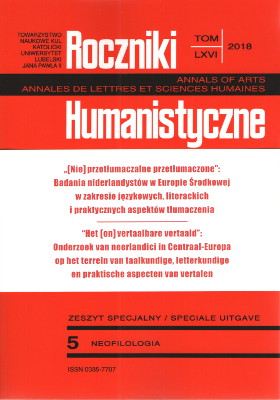Bij wijze van inleiding
By way of introduction
Author(s): Wilken Engelbrecht, Bas Hamers, Muriel WaterlotSubject(s): Essay|Book Review |Scientific Life, Editorial
Published by: Towarzystwo Naukowe KUL & Katolicki Uniwersytet Lubelski Jana Pawła II
Keywords: Dutch Studies; translation; terminology; linguistics; literature; jubilee; John Paul II Catholic University of Lublin
Summary/Abstract: In the academic year 2017/18, 40 years have passed since the beginning of the teaching of Dutch in Lublin. With the support of the Catholic University of Leuven and the Catholic University of Nijmegen, Eugeniusz Wiśniowski began in 1977 a Dutch language course, upgraded in 1979 into a Dutch Cultural Center. Wiśniowski was the director of the center till his retirement in 1983. His successor was Michał Kaczmarkowski, who ran the center until 2001. In 2007, the Department of Dutch Literature and Language was established (directors: 2007–2010 Koen Jaspaert and 2010–2012 Maarten Klein). The master program was also created at that time.To celebrate the 40th anniversary of conducting classes in the Dutch language, a conference Het (on)vertaalbare vertaald was organized, the result of which is this special issue of Roczniki Humanistyczne, issue 5: Neofilologia. Part 1 deals with terminological issues. Frieda Steurs wonders how a specialist language functions as a link between the economy and society. Marketa Štefková and Pavlína Knap-Dlouhá treat the aspects of legal terminology. Koen Kerremans describes terminology from a translatological perspective. Two papers refer to on medical terminology: Ewa Majewska discusses the influence of foreign languages on Dutch medical terminology, and Chris Joby deals with the influence of the Dutch language on Japanese by translating Japanese medical books into Dutch.Part 2 focuses on didactic problems. Agata Kowalska-Szubert focuses on the typical translation problems of the so-called “small words.” Muriel Waterlot presents a model of dealing with business translations in learning a foreign language, and Milan Kříž continues this thread by showing how he incorporates translation components into the undergraduate program.Part 3 is devoted to elements of culture. Ludo Beheydt presents a semiotic approach to the translatological problem. The article by Kateřina Křížova refers to this approach, the author looks at the translations of established comparisons as linguistic and cultural components in Czech.The themes of the articles in part 4 concern literary translations. Ton Naaijkens shows how much the translation of seemingly simple texts can be influenced by the perspective of translators and their translatological filter. The medievalists Małgorzata Dowłaszewicz and Ludo Jongen are looking at the specific problem of translating medieval texts. Beata Popławska deals with translating diminutives in French with their counterparts in Dutch and Polish on the basis of Le Petit Prince of Antoine de Saint-Exupéry. The section closes Pim van der Horst with an article about translating subtitles in movies.Part 5 presents the reception of literary works in translation. Wilken Engelbrecht deals with Czech translations of several Dutch novellas from the beginning of the 20th century in the series 1000 nejkrásnějších novel 1000 světových spisovatelů, which, on closer inspection, look translated not from Dutch but from French. Magdalena Lipnicka deals with the problem of translating “realities” in the Polish translation of Tonke Dragt’s De brief voor de koning.In part 6 there are texts on the didactic aspect of literary translations. Marcin Polkowski explains how the adaptation of ancient Dutch texts into contemporary Dutch can be used as an aid in the didactic development of old literature. On the other hand, Benjamin Bossaert shows how you can incorporate literary translation as a didactic component into a practically oriented Dutch education curriculum.At the end of the issue some varia are placed. Anna Krýsová reflects on the poetry of Mustafa Stitou, and Małgorzata Łyczykowska reflects on the role of unofficial Polish press offices in war propaganda during the First World War.
Journal: Roczniki Humanistyczne
- Issue Year: 66/2018
- Issue No: 5S
- Page Range: 11-16
- Page Count: 6
- Language: Dutch

